This article refers to Barracuda Message Archiver Legacy Release firmware or higher, and Microsoft Exchange Server 2007 and 2010.
Barracuda Networks recommends deploying your Barracuda Message Archiver with Microsoft Exchange Server 2007/2010 using the push method, alternately, you can set up IMAP or POP3 journal accounts as described in this article.
You can configure the Barracuda Message Archiver to automatically retrieve messages directly from your mail server using the IMAP or POP3 protocol.
Service Availability
To verify that the IMAP or POP3 service is available on the Exchange Server.
- Log into the Exchange Server as the Exchange Server Administrator.
- Go to All Programs > Microsoft Exchange Server > Exchange Management Console.
- In the Console tree, navigate to and click Client Access.
- In the Work pane, click the POP 3 and IMAP 4 tab:
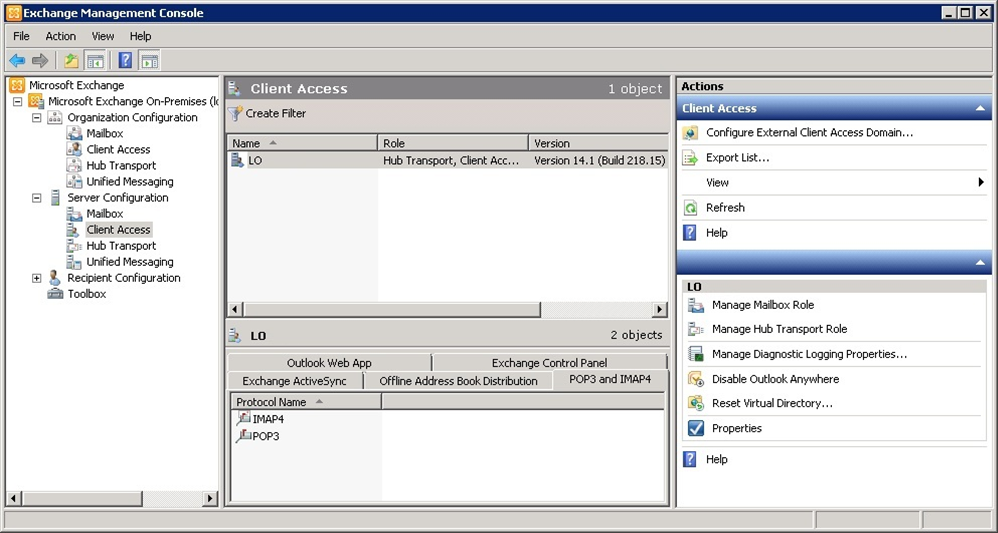
- Right-click on the desired service, for example, IMAP4, and click Properties.
- In the General tab, verify the service is "ready" in the Banner string window:
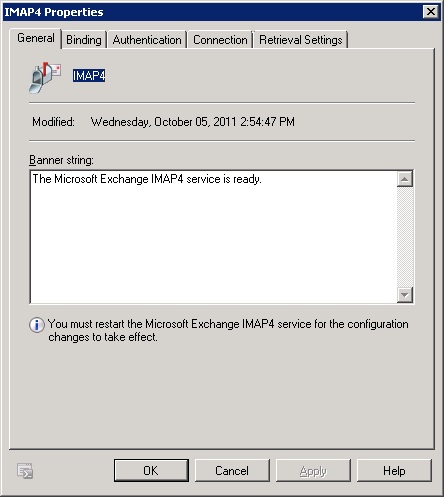
- Click the Binding tab to view the default port for the service:
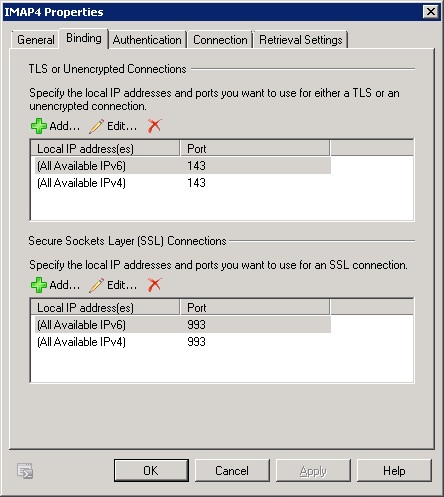
- To modify the port number, select from the available options:
- Add – Click to add an additional port number
- Edit – Click to modify the port details for the highlighted item
- Delete – Click to remove the highlighted port from the list
- Click OK to save your changes and close the dialog box.
Set Exchange Rich-Text Format to Never Use
Start the Service
To start the service:
- Log into the Exchange Server as the Exchange Server Administrator, and go to Start > Programs > Administrative Tools > Services.
- Locate and click the desired service in the Services window, for example, Microsoft Exchange IMAP 4:

- Right-click on the service name, and click Properties.
- In the Properties dialog box, select Automatic from the Startup type drop-down menu:
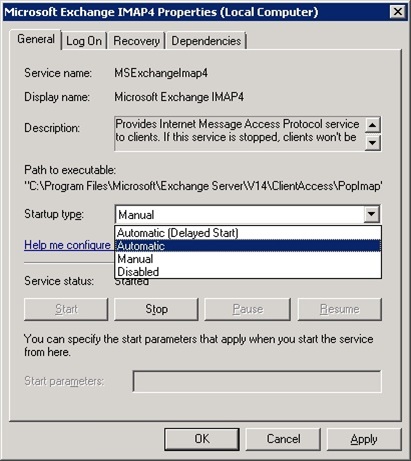
- Click Start, and then click OK to save your settings.
- In the Services window, verify the Status is Started and the Startup Type is Automatic:
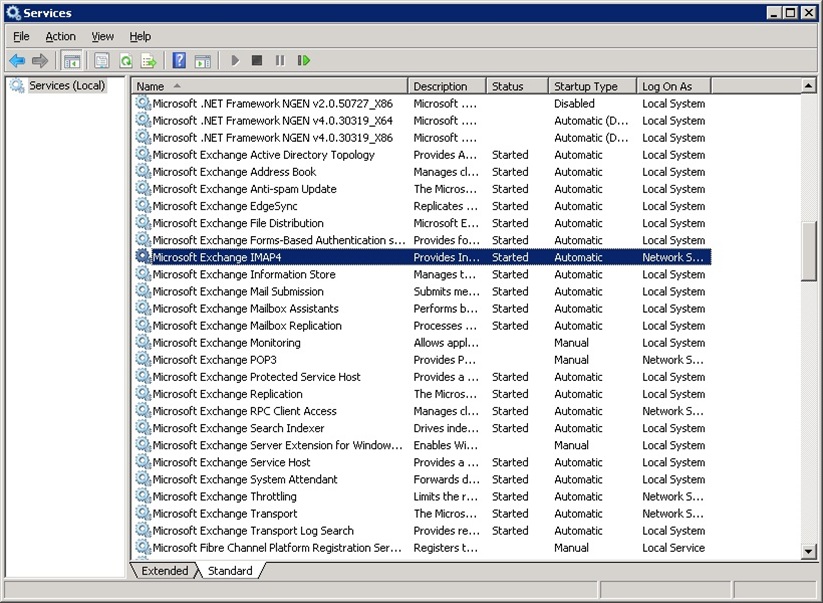
- Close the Services window.
Add a Journal Account to the Barracuda Message Archiver
Once you configure the service on your Exchange Server, you can add the journal account to the Barracuda Message Archiver to begin retrieving new messages for archiving.
- Log into the Barracuda Message Archiver as the administrator, and go to MAIL SOURCES > Journal Accounts.
- In the Journal Accounts section, enter the following details:
- Enable Journal Accounts – Select Yes to allow the Barracuda Message Archiver to poll the listed accounts for new messages for archiving.
- Enable Journal Testing – When set to Yes, all listed accounts are tested for connectivity with each page view.
- Polling Frequency – Specify how often to poll each journal account for new messages
- In the Journal Accounts Configuration section, specify the following details for each journal account:
- Status – Displays the connection status for each account.
- Server – Enter the hostname of the mail server where the account resides.
- Protocol – Select whether the account is POP3 or IMAP; once you select the protocol, the default port number automatically populates the Port field.
- Username – Enter the username or ID associated with this mailbox as defined by your server. This is usually the mailbox designated as the "journaling" email address on your mail server, and specified by the complete email address such as journal@example.com.
- Password – Enter the password associated with the username.
As a best practice, use a unique account for this integration point and grant it the least level of privileges required, coordinating with the system administrator. This journaling account requires write privileges for the associated mailbox on the mail server. For additional information, see Security for Integrating with Other Systems - Best Practices. - Encryption – Select the type of encryption used to connect to the mail server:
- TLS (if available)
TLS
SSL
- None
- Port – Select the associated port based on the selected protocol; the default value is port 143 for IMAP, and port 110 for POP3.
- Keep Items on Server:
- Select Off to allow the Barracuda Message Archiver to automatically clean up the contents of the journal mailbox after each import.
Select On to prevent the Barracuda Message Archiver from removing the journaled messages from the mail server; only turn this option on if the contents of the journal account is required by other applications. In this case, make sure that another method for cleaning up the journal account is enabled on the mail server in order to prevent unlimited growth on the mail server and to stay in compliance with your organization’s message retention policies.
- Click Add to add the journal account; verify the Status field displays green, and then click Save.
- To remove a journal account, click the Delete (
 ) icon, and confirm you want to remove the account.
) icon, and confirm you want to remove the account.
Add a Journaling Rule
- Log into the Exchange Server as the Exchange Server Administrator.
- Go to All Programs > Microsoft Exchange Server > Exchange Management Console.
- In the Console tree, expand Organization Configuration, select Hub Transport, and and select the Journal Rules tab.
- In the Actions panel, click New Journal Rule ; the New Journal Rule dialog displays.
- In the New Journaling Rule dialog box, enter a Rule Name, for example, type
Archive. - In the Send Journal reports to e-mail address field, enter the username of the mailbox designated as the "journaling" email entered in the Username field in the previous set of steps.
- Select the Scope option:
Global (recommended) – All messages
External – Only messages to and from other mail servers
Internal – Only internal messages
- Turn off Journal messages for recipient, and turn on Enable Rule:
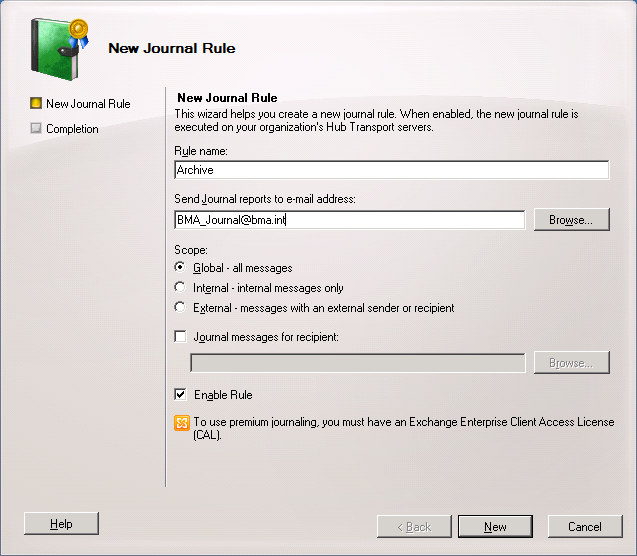
- Click New to create the Journaling rule, and click Finish to return to the Journal Rules tab where the newly-created rule displays in the list.
